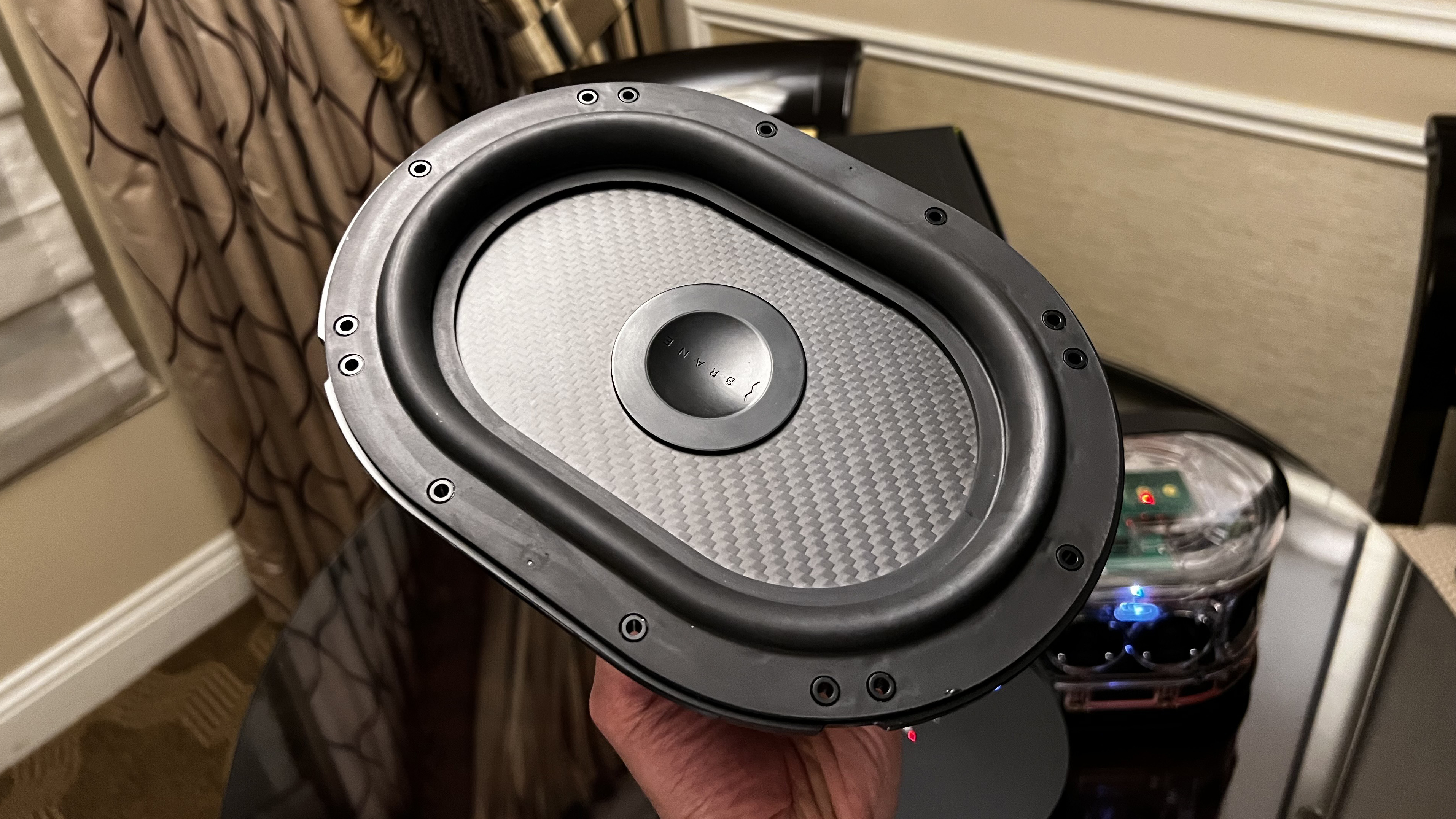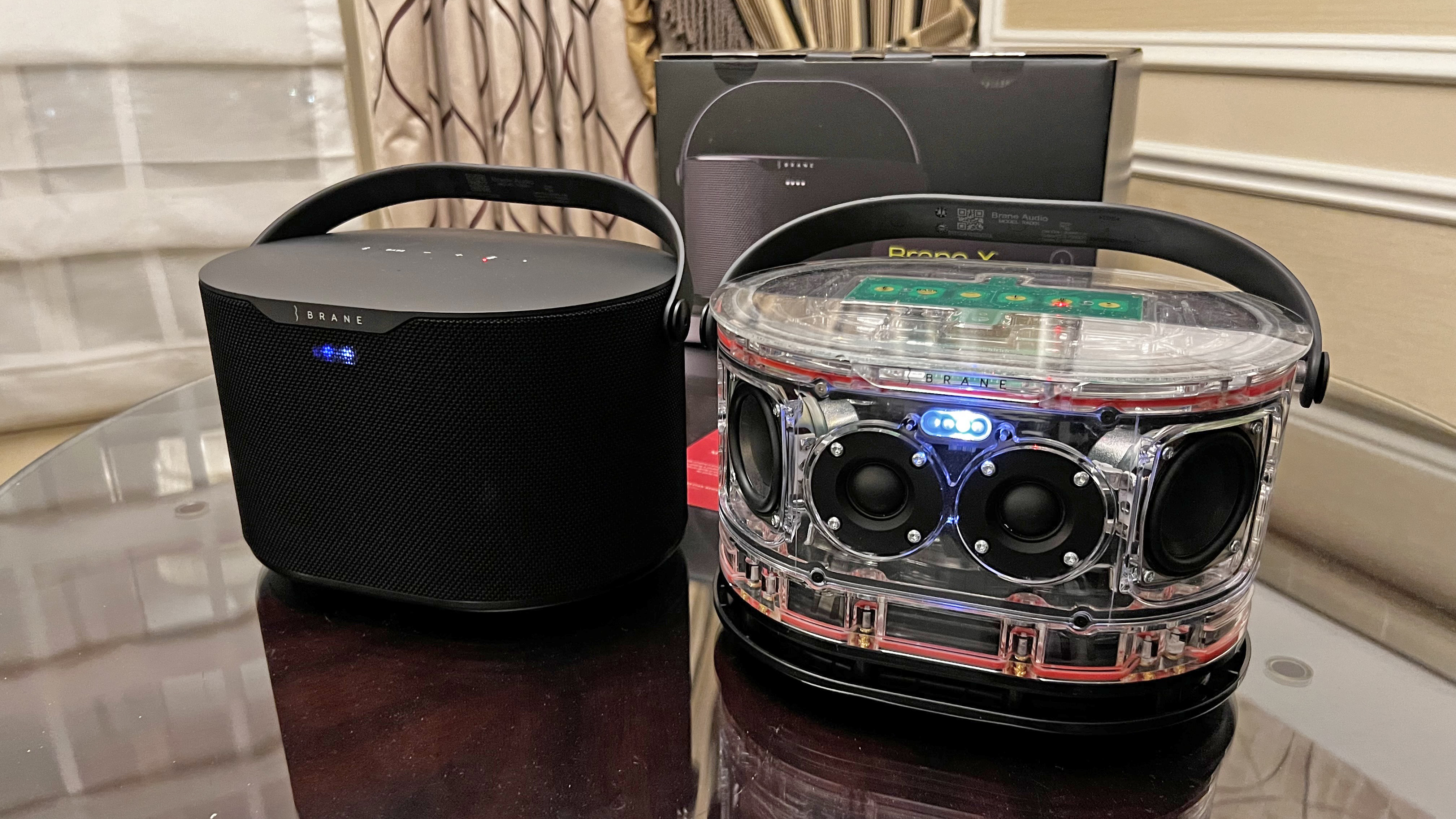A game-changing small wireless speaker with a real subwoofer inside pretty much blew me off my feet

It's not often that I think that something I saw in January has basically ruined that kind of product for me for the rest of the year, but the Brane X has probably done that thing. It's a competitor to the best wireless speakers with Bluetooth and Wi-Fi connectivity on board, in a body that's a similar size to the Bang & Olufsen A5 – ie, similar to a small two-slice toaster – but it has something none of its rivals have: a real, bona fide subwoofer.
Great bass requires large drivers that can move a lot of air. Smaller speakers use something like a combination of a woofer driver with a bass reflex port to make this work as best they can, because it's possible to fit this tech in a smaller body, and using the kind of low power levels that the best Bluetooth speakers can provide. But it's nothing compared to what a real subwoofer or a larger bass-focused driver setup can do.
The Brane X speaker has a real subwoofer, alongside two tweeters and two mid-range woofers. It's a design unique to Brane, so that it can actually work in this kind of product, and is equivalent to an eight-inch subwoofer according to Brane, which for reference is what you get with the Samsung HW-Q800C soundbar in a separate box from the bar. But that box alone is about three times the volume of the Brane X speaker, despite not including all the other tech the Brane X has.
And this is not just some folly that a company has done 'because it can' – from the second the Brane X is playing music and you can feel the drums and bassline in your diaphragm, despite it being such a unimposing device sitting on a table, you know the game has changed. It's a bright and energetic sound for most of a pop song, but when the bass kicks in, the floor just drops out beneath you in a way that's unbelievable for something the size of an artisan sourdough loaf.

First, here's how Brane's subwoofer is different to a regular sub. Fundamentally, it's all about the magnet design, and overcoming air pressure. At its heart, the tech is the same as the dynamic driver coil systems that all subwoofers use, where a coil with a magnetic field moves magnets in the center of a driver cone to push air.
The problem with a subwoofer in a small, sealed space like a Bluetooth speaker is air pressure. If you're moving this big driver back and forth, you're compressing air inside the unit, which resists the movement of the driver so it can't make its sound properly. To overcome that, you can just push the magnets harder, but this means that subwoofers use a lot of power. Far more than is reasonable to drive from a battery. Hence, no subwoofers in portable speakers.
Brane's design uses a series of strong separate magnets that replace part of the voice coil itself, and these have the sole job of overcoming the air compression. As the air pressure increases, the power in these magnets matches it exactly, neutralizing the way that this pressure resists the movement of the driver. This means that the driver is able to move 'freely' without using more power – the strong-but-low-power magnets are handling all the extra force.
Sign up for breaking news, reviews, opinion, top tech deals, and more.
I liken it to one of these exoskeletons that are designed to help people lift heavy objects. You move normally within the suit, and the motors in the suit detect weight and put all their motor power in to do the lifting, so it's like you're lifting nothing at all.
The Brane team agrees that's a fair analogy, although they think of it like a Steadicam. In a Steadicam, the huge weight of a pro camera is balanced on a pivot, with a plain equal weight on the back, meaning that you can move it smoothly because it's balanced.
Whatever metaphor you prefer, it's clear that Brane is onto something huge – there was a bet between the founders as to whether it would work or not, because it seemed "too good to be true". (To be fair, the first version didn't work, but they fixed that.)

The end result of all this is that it's like having a car with a serious subwoofer system parked in the room with you. I felt like the guy in the Maxell tape ad sitting across from it in the hotel room, in the best possible way. If I'd been facing a pair of huge floorstanding speakers or if I were in a home theater system demo, I'd have expected this kind of power – it catches you unawares from the compact black oval.
To be clear, though, it's not too much. Using the app, you can switch from high bass to low bass if you prefer something with less power but still with greater depth than other speakers provide – but the sound seems really well balanced with the bass, based on my time with it.
Obviously, big bass is great with pop or hip-hop, and I tried a few options along these lines. But I also heard it with acoustic music, and you should never underestimate how rich bass adds to the feeling of realism from a piano or string instrument, because you can feel resonance of notes through the body. It absolutely adds hugely to the experience.
I also listened to a snippet of the Blade Runner 2049 soundtrack, and you get so much more of a cinema-like depth to the sound than – well, pretty much anything I've heard this on since movie theaters.
I also heard it in comparison to the similarly sized JBL Xtreme 3, and the considerably larger UE Hyperboom. Switching between the JBL and the Brane X was like going from 2D to 3D. Matching the volumes as best we could, the JBL Xtreme 3 – not a speaker I would ever describe as weedy! – sounded so thin in comparison. It was a similar story for the UE Hyperboom, which is capable of huge power and is at least twice the volume of the Brane X, but the extra low-end of the Brane X makes you think they'd be the other way round in terms of sizing.
However, these two speakers do have a huge advantage over the Brane X: price. The $379 for the JBL Xtreme 3 and the $409 for the UE Hyperboom are a full third cheaper than the $599 of the Brane X.

The Brane X is also a beast. It's clearly built like a safe, and weighs like one too: at 7.7 lbs / 3.5kg it's about 40% heavier than the JBL Xtreme 3. It's heavier even than the Sonos Move 2, though at least it has a proper handle, unlike the Sonos.
The subwoofer obviously adds to the weight, but I suspect the solidity of its build is a factor here too. That subwoofer is putting a lot of force into the body of the unit that needs to be handled without vibration. The Brane X sits on particularly soft rubber feet, and the team tells me that without them, "it wants to run around the table". Even with them, I suspect that putting it on the same shelf as your fine china is unwise.
You can even link two Brane X's in a stereo pair, or it supports multi-room over AirPlay or Spotify Connect. It promises a battery life of 12 hours – again, only possible because the subwoofer doesn't draw significantly more power than other speaker drivers, unlike regular subwoofers.
It's available to order now in the US, from Brane's own website, though it will come to other retailers at some point. A release in the rest of the world is targeted for late in 2024.
You might also like

Matt is TechRadar's Managing Editor for Entertainment, meaning he's in charge of persuading our team of writers and reviewers to watch the latest TV shows and movies on gorgeous TVs and listen to fantastic speakers and headphones. It's a tough task, as you can imagine. Matt has over a decade of experience in tech publishing, and previously ran the TV & audio coverage for our colleagues at T3.com, and before that he edited T3 magazine. During his career, he's also contributed to places as varied as Creative Bloq, PC Gamer, PetsRadar, MacLife, and Edge. TV and movie nerdism is his speciality, and he goes to the cinema three times a week. He's always happy to explain the virtues of Dolby Vision over a drink, but he might need to use props, like he's explaining the offside rule.